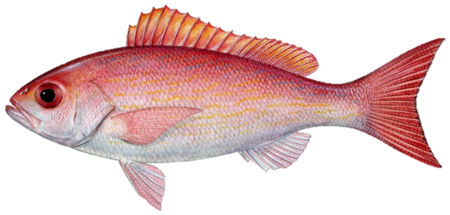
Scientific Name
Rhomboplites aurorubens
Common Names
Beeliner
B-liner
Mingo
Stock Status
Overfishing – No
Overfished – No
Recreational Regulations
Federal Regulations
-
Open year-round
- 10 Bag Limit
- 20 Aggregate Limit
- Minimum Size: 10 in Total Length
- Additional Licenses Required: Beginning July 1, 2020, anglers intending to land this species in Florida are required to sign up as a Florida State Reef Fish Angler if they fish from a private recreational boat and are 16 years of age and older. To sign up, call 1-888-347-4356.
Gear Description: Non-stainless steel circle hooks are required when fishing with natural baits. At least one dehooking device is required and must be used to remove hooks.
Notes: Anglers required to have a venting tool or descending device rigged and ready to use when fishing for reef fish species in Gulf of Mexico federal waters. For more information, see NOAA Descend Act.
To see commercial regulations, download Fish Rules Commercial App for iOS devices or Android devices.
Commercial Regulations
Harvest Limits
| Sector | Annual Catch Limit |
| Stock | 5,452,500 pounds |
Additional Information
Description
Vermilion snapper, also known as “mingo” and “beeliner”, is found from North Carolina south to Florida, including the Gulf of Mexico, and further south through the Bahamas and the Caribbean Sea to southern Brazil. It is a deep vermilion red color, hence its name, on the sides above the lateral line and a pale pinkish to silver below. The sides may have narrow yellow lines below the lateral line. This species is also one of the smaller fish in the snapper family. Other distinguishing characteristics include large red eyes, a short snout and a broadly rounded anal fin.
Maximum observed age: 26 years1
Age at maturity: 2 years2, 3
Maximum weight: 7.19 pounds (3.26 kilograms)3, 4
Maximum length: 24.80 inches (63 centimeters)3
Life History and Distribution
This snapper is abundant over rocky reefs, gravel and sand bottoms off the edges of continental shelves at deeper depths. Adults form large schools. Although the spawning behavior of vermilion snapper is poorly studied, adults spawn within large schools near structure throughout the year. It is described as a resident aggregation spawner because it spawns in the same area it often frequents. In the Gulf of Mexico, vermilion spawn from April to September; peak spawning occurs June to August.3
References
- SEDAR 45 Final Stock Assessment Report: Gulf of Mexico Vermilion Snapper
- Farmer, N.A., Malinowski, R.P., McGovern, M.F. and Rubec, P.J. (2016), Stock Complexes for Fisheries Management in the Gulf of Mexico. Marine and Coastal Fisheries, 8: 177-201. doi:10.1080/19425120.2015.1024359
- Kobara, S., B. Erisman, W. Heyman, C. Biggs, N. Farmer, S. Lowerre-Barbieri, M. Karnauskas, and J. Brenner. 2017. Cooperative monitoring program for spawning aggregations in the Gulf of Mexico: data portal. Version 1.0 GCOOS, USA.
- IGFA All Tackle Record, Mobile, Alabama

